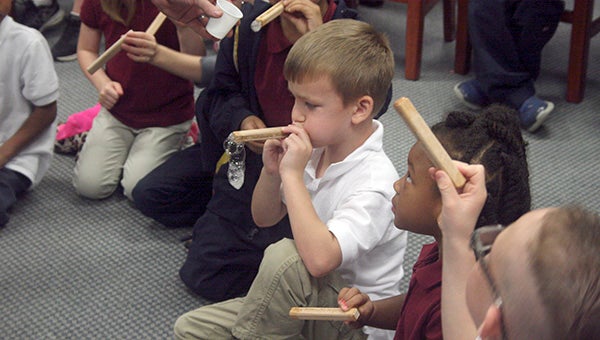Students learn the magic of wood
Published 7:00 am Friday, April 1, 2016

RED OAK: Students blow bubbles through pieces of red oak as part of a demonstration to show how the wood has vessels that transport water to the rest of the tree. White oak has special vessel blockers that makes it an ideal wood to build a boat.
Photo by Jeremy Pittari
Wood is a plentiful resource used in a variety of everyday products. Its versatility was demonstrated to a group of students at Nicholson Elementary Thursday morning.
The presentation is called the Wood Magic Science Fair and was put on by representatives of Mississippi State University’s Wood Science and Technology of Sustainable Bioproducts.
A video about wood products and how they are used to build a home kicked the presentation off. The video demonstrated how wood was used in the construction of a two-story single family home utilizing 25 trees worth of wood. For every tree cut down, five seedlings are planted in its place, according to the video.
After the video, the children heard about how important wood is to society. Dan Seale, a professor at MSU, said not only is wood made into boards, plywood and paper products, but some of the byproducts are used in ketchup and toothpaste as thickening agents. Vanilla extract is also made from wood byproducts, which is why it’s cheaper than the pure vanilla made from vanilla beans.
The students also got involved in a live demonstration about the strength of wood. A small piece of wood was shaved down in the middle to the size of a toothpick.
That piece of wood was bolted onto a specially made mount that allowed a bucket to be suspended from the piece of wood. Essentially, the full weight of the bucket was being held by the smallest section of the wood. Then a bit of math was mixed into the presentation by having the students keep track of how much weight was being added to the bucket in incremental steps. After adding several weight bags to the bucket, the piece of wood finally broke after supporting 100 pounds. Research Assistant Edward Entsminger said the demonstration was an example of the many types of research their department conducts on wood.
A second demonstration utilized termites. Two students were chosen from the crowd to write their names. One student used a pen with red ink, while the second used a pen with black ink. Then some termites were placed on the paper in a controlled environment. MSU Assistant Professor Jason Street explained that just like ants, termites follow chemical trails. He then let the children watch as the termites gathered around the black ink, which contains a chemical that attracted the wood-eating insects. Some of the research going on at MSU involves determining ways to deter termites from a home, such as with the use of radio waves.
The last demonstration involved showing how wood can have holes capable of absorbing water. In this demonstration children were given a piece of red oak, as opposed to white oak. Seale told the children that both red and white oak trees use vessels to carry water to the leaves, but white oak has a vessel blocking feature, called tyloses, which makes it a suitable wood for the construction of boats.
To demonstrate how red oak lacks this structure in their vessels and thereby allow water and air to pass through, a piece of the wood was provided to each student. They then dipped the wood into soapy water, and blew through it to creates bubbles.



